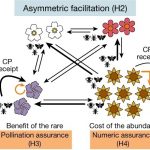Plant Science Research Weekly: October 29, 2021
Special Issue of J. Exp. Bot. The quiescent center and root apical meristem: Organization and function
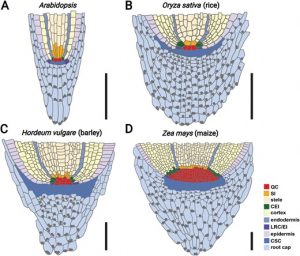 As the name suggests, the root quiescent center (QC) is an area at the root tip of low cell-division activity. This special issue of the Journal of Experimental Botany provides a comprehensive overview of what we understand about the QC and its importance in root growth. The issue is dedicated to the memory of Frederick Clowes on what would have been his 100th birthday. Clowes built upon previous studies wherein the root apical meristem had been shown to be a region of high cell division activity. Through radioactive labeling followed by sectioning and autoradiography, Clowes identified these quiescent cells within the root apical meristem. His and others’ studies subsequently demonstrated that the QC cells not only provide a reservoir of initial cells (less prone to mutation as a consequence of their lower rate of division) but also that the QC acts as an organizer that controls patterning and cell identity acquisition. The articles in this issue cover insights about QC formation, maintenance, and function that have been gleaned through studies in large-rooted plants (including maize and radish) as well as genetic approaches in Arabidopsis. (Summary by Mary Williams @PlantTeaching) J. Exp. Bot. Vol 72, Issue 19, October 2021.
As the name suggests, the root quiescent center (QC) is an area at the root tip of low cell-division activity. This special issue of the Journal of Experimental Botany provides a comprehensive overview of what we understand about the QC and its importance in root growth. The issue is dedicated to the memory of Frederick Clowes on what would have been his 100th birthday. Clowes built upon previous studies wherein the root apical meristem had been shown to be a region of high cell division activity. Through radioactive labeling followed by sectioning and autoradiography, Clowes identified these quiescent cells within the root apical meristem. His and others’ studies subsequently demonstrated that the QC cells not only provide a reservoir of initial cells (less prone to mutation as a consequence of their lower rate of division) but also that the QC acts as an organizer that controls patterning and cell identity acquisition. The articles in this issue cover insights about QC formation, maintenance, and function that have been gleaned through studies in large-rooted plants (including maize and radish) as well as genetic approaches in Arabidopsis. (Summary by Mary Williams @PlantTeaching) J. Exp. Bot. Vol 72, Issue 19, October 2021.
Review. A glossary of plant cell structures: Current insights and future questions
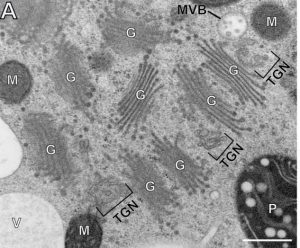 In a contribution to the January 2022 Plant Cell Focus Issue on Plant Cell Biology, Kang et al. have assembled an updated survey of plant cell structures. This review includes a dozen mini-reviews that describe various compartments or structures within plant cells: the nucleus, endoplasmic reticulum, Golgi stacks, endosomes, vacuole, lipid droplets, peroxisomes, mitochondria, chloroplast, membrane contact sites, plasmodesmata, and cell wall. Each review describes what the structure does, as well as its origins, distribution, diversity, and dynamic nature. As advances in imaging tools have recently contributed to tremendous strides in our understanding of plant cell structures, this review is a powerful and much needed resource and will be useful for teaching. Furthermore, the glossary is beautifully illustrated and includes supplemental video files like the one shown below. (Summary by Mary Williams @PlantTeaching) Plant Cell 10.1093/plcell/koab247.
In a contribution to the January 2022 Plant Cell Focus Issue on Plant Cell Biology, Kang et al. have assembled an updated survey of plant cell structures. This review includes a dozen mini-reviews that describe various compartments or structures within plant cells: the nucleus, endoplasmic reticulum, Golgi stacks, endosomes, vacuole, lipid droplets, peroxisomes, mitochondria, chloroplast, membrane contact sites, plasmodesmata, and cell wall. Each review describes what the structure does, as well as its origins, distribution, diversity, and dynamic nature. As advances in imaging tools have recently contributed to tremendous strides in our understanding of plant cell structures, this review is a powerful and much needed resource and will be useful for teaching. Furthermore, the glossary is beautifully illustrated and includes supplemental video files like the one shown below. (Summary by Mary Williams @PlantTeaching) Plant Cell 10.1093/plcell/koab247.
Exogenous miRNAs induce post-transcriptional gene silencing in plants
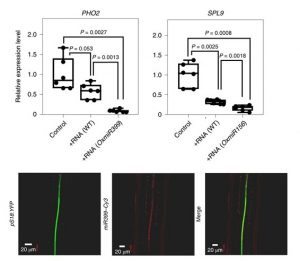 Small RNAs (sRNAs) are 21- to 24-nucleotide non-coding RNAs that induce gene silencing by targeting specific mRNAs for degradation. They regulate a plethora of developmental and physiological processes. Based on their biogenesis they are classified into two groups: micro-RNAs (miRNAs) and siRNAs. Within a plant, sRNAs act locally or over long distances by moving throughout the vasculature. Additionally, sRNAs can move between plants and interacting organisms and induce cross-kingdom/organism RNA silencing. However, whether plants can uptake sRNAs from their environment or use them as signaling molecules in plant-to-plant communication remains unknown. Here, Betti et al. show that two well studied miRNAs produced by plants, miR156 and miR399, act as signaling molecules affecting gene expression in nearby plants. By exogenously applying miR156 and miR399 to Arabidopsis seedling in vitro, the authors demonstrate that both miRNAs affect expression of their targets, the E2 conjugase PHO2 and the SQUAMOSA-PROMOTER BINDING PROTEIN-LIKE (SPL) transcription factors respectively. Additionally, the authors observed miR399 uptake and transportation through the xylem and found that silencing functions of both miRNAs required the action of ARGONAUTE1 protein (AGO1) and RNA-DEPENDENT RNA POLYMERASE6 (RDR6), which implies the production of secondary small interfering RNAs. Co-cultivation experiments of WT and plants that overexpress miR399 or miR156 showed that the high secreted levels of miRNAs from the overexpression lines induced equivalent low expression levels of PHO2 and SPL targets in WT, suggesting a plant-to-plant interaction mediating gene silencing. Together, these results provide evidence of a signaling mechanism that involves miRNAs and gene silencing in plant communication. (Summary by Daniela Ramos @DanielaR_cruz) Nature Plants 10.1038/s41477-021-01005-w.
Small RNAs (sRNAs) are 21- to 24-nucleotide non-coding RNAs that induce gene silencing by targeting specific mRNAs for degradation. They regulate a plethora of developmental and physiological processes. Based on their biogenesis they are classified into two groups: micro-RNAs (miRNAs) and siRNAs. Within a plant, sRNAs act locally or over long distances by moving throughout the vasculature. Additionally, sRNAs can move between plants and interacting organisms and induce cross-kingdom/organism RNA silencing. However, whether plants can uptake sRNAs from their environment or use them as signaling molecules in plant-to-plant communication remains unknown. Here, Betti et al. show that two well studied miRNAs produced by plants, miR156 and miR399, act as signaling molecules affecting gene expression in nearby plants. By exogenously applying miR156 and miR399 to Arabidopsis seedling in vitro, the authors demonstrate that both miRNAs affect expression of their targets, the E2 conjugase PHO2 and the SQUAMOSA-PROMOTER BINDING PROTEIN-LIKE (SPL) transcription factors respectively. Additionally, the authors observed miR399 uptake and transportation through the xylem and found that silencing functions of both miRNAs required the action of ARGONAUTE1 protein (AGO1) and RNA-DEPENDENT RNA POLYMERASE6 (RDR6), which implies the production of secondary small interfering RNAs. Co-cultivation experiments of WT and plants that overexpress miR399 or miR156 showed that the high secreted levels of miRNAs from the overexpression lines induced equivalent low expression levels of PHO2 and SPL targets in WT, suggesting a plant-to-plant interaction mediating gene silencing. Together, these results provide evidence of a signaling mechanism that involves miRNAs and gene silencing in plant communication. (Summary by Daniela Ramos @DanielaR_cruz) Nature Plants 10.1038/s41477-021-01005-w.
Pollinators contribute to the maintenance of flowering plant diversity
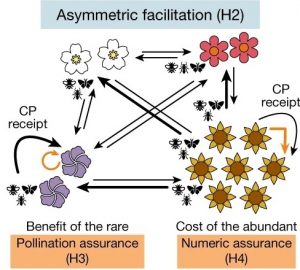 How do small populations persist in spite of sharing space with much larger populations? Wei et al. explored this question in the context of plant-pollinator interactions. They observed that rarer species tend to attract more specialized pollinators, whereas more abundant species have more shared pollinators, leading to reduced reproductive success as their pollinators were more likely to carry heterospecific pollen (from another species). This effect is termed niche specialization, and the authors showed that floral traits contribute to it. Even when they share pollinators, the rarer species benefit from the overall greater pollinator presence, whereas the abundant species suffer lower pollination rates than when grown alone, leading to lower fitness, which is termed asymmetric facilitation. The findings of this study show that conserving biodiversity relies on conserving functioning communities of plants and pollinators, not solely plant species. (Summary by Mary Williams @PlantTeaching) Nature 10.1038/s41586-021-03890-9
How do small populations persist in spite of sharing space with much larger populations? Wei et al. explored this question in the context of plant-pollinator interactions. They observed that rarer species tend to attract more specialized pollinators, whereas more abundant species have more shared pollinators, leading to reduced reproductive success as their pollinators were more likely to carry heterospecific pollen (from another species). This effect is termed niche specialization, and the authors showed that floral traits contribute to it. Even when they share pollinators, the rarer species benefit from the overall greater pollinator presence, whereas the abundant species suffer lower pollination rates than when grown alone, leading to lower fitness, which is termed asymmetric facilitation. The findings of this study show that conserving biodiversity relies on conserving functioning communities of plants and pollinators, not solely plant species. (Summary by Mary Williams @PlantTeaching) Nature 10.1038/s41586-021-03890-9



